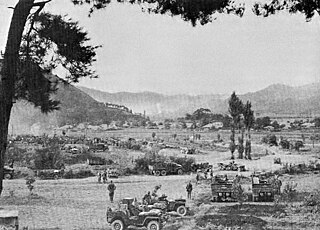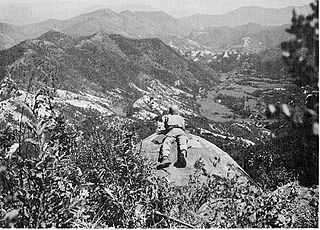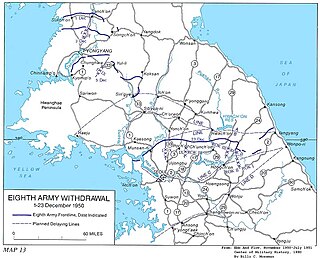Related Research Articles

The 7th Cavalry Regiment is a United States Army cavalry regiment formed in 1866. Its official nickname is "Garryowen", after the Irish air "Garryowen" that was adopted as its march tune.
II Corps is a field corps of the Republic of Korea Army and it was active in the Korean War. It is also known as Double Dragons.
The 27th Infantry Division was a military formation of the Korean People's Army, as part of the II Corps.
The II Corps is a corps of the Korean People's Army. It was created on June 12, 1950 with Lt. General Kim Kwang-hyop in command. During the Korean War the unit was composed of the 2nd Infantry Division, the 5th Infantry Division, and the 12th Infantry Division.
The Battle of Kujin, also known as the Battle of the Broken Bridge, took place during the United Nations Command (UN) offensive towards the Yalu River, which followed the North Korean invasion of South Korea at the start of the Korean War. The battle was fought between Australian forces from 3rd Battalion, Royal Australian Regiment and elements of the 17th Tank Brigade of the Korean People's Army (KPA) over a key bridge across the Taeryong River near Kujin, North Korea. On 25 October the 27th British Commonwealth Brigade had resumed their advance towards Pakchon after crossing the Chongchon River, with 3 RAR as the lead battalion. Arriving at Kujin, the Australians discovered that the centre span of the 300-metre (330 yd) concrete bridge had been demolished by KPA engineers, blocking their passage across the river. A platoon-sized reconnaissance patrol crossed the river using debris from the destroyed span; however, it was soon forced to withdraw by KPA holding the high ground. Airstrikes and artillery fire were subsequently called in at 17:15 by the Australians as they prepared to conduct an assault.

The Battle of Chongju took place during the United Nations Command (UN) offensive towards the Yalu River, which followed the North Korean invasion of South Korea at the start of the Korean War. The battle was fought between Australian forces from 3rd Battalion, Royal Australian Regiment and the 17th Tank Brigade of the Korean People's Army (KPA) for control of Chongju, North Korea and the surrounding area. After detecting a strong KPA armoured force equipped with T-34 tanks and SU-76 self-propelled guns on a thickly wooded ridgeline astride the line of advance, the Australians launched a series of company attacks with American M4 Sherman tanks and aircraft in support. Despite heavy resistance the KPA were forced to withdraw and the Australians captured their objectives after three hours of fighting.

The Battle of Unsan, also known as the Battle of Yunshan, was a series of engagements of the Korean War that took place from 25 October to 4 November 1950 near Unsan, North Pyongan province in present-day North Korea. As part of the People's Republic of China's First Phase Campaign, the People's Volunteer Army (PVA) made repeated attacks against the Republic of Korea Army (ROK) 1st Infantry Division near Unsan beginning on 25 October, in an attempt to take advancing United Nations Command (UNC) forces by surprise. In an encounter with the United States military, the PVA 39th Corps attacked the unprepared U.S. 8th Cavalry Regiment in Unsan on 1 November, resulting in one of the most devastating U.S. losses of the war.

The Battle of Taejon was an early battle of the Korean War, between U.S. and North Korean forces. Forces of the United States Army attempted to defend the headquarters of the 24th Infantry Division. The 24th Infantry Division was overwhelmed by numerically superior forces of the Korean People's Army (KPA) at the major city and transportation hub of Taejon. The 24th Infantry Division's regiments were already exhausted from the previous two weeks of delaying actions to stem the advance of the KPA.

The Battle of the Ch'ongch'on River, also known as the Battle of the Ch'ongch'on, was a decisive battle in the Korean War, and it took place from November 25 to December 2, 1950, along the Ch'ongch'on River Valley in the northwestern part of North Korea. In response to the successful Chinese First Phase Campaign against the United Nations (UN) forces, General Douglas MacArthur launched the Home-by-Christmas Offensive to expel the Chinese forces from Korea and to end the war. Anticipating this reaction, the Chinese People's Volunteer Army (PVA) Commander Peng Dehuai planned a counteroffensive, dubbed the "Second Phase Campaign", against the advancing UN forces.

The Battle of Taegu was an engagement between United Nations Command (UN) and North Korean forces early in the Korean War, with fighting continuing from August 5–20, 1950 around the city of Taegu, South Korea. It was a part of the Battle of Pusan Perimeter, and was one of several large engagements fought simultaneously. The battle ended in a victory for the UN after their forces were able to drive off an offensive by Korean People's Army (KPA) divisions attempting to cross the Naktong River and assault the city.

In the Battle of the Bowling Alley , United Nations Command (UN) forces defeated North Korean forces early in the Korean War near the city of Taegu, South Korea. The battle took place in a narrow valley, dubbed the "Bowling Alley", which was north of Taegu. It followed a week of fighting between the Korean People's Army (KPA) 13th Division and the Republic of Korea Army's (ROK) 1st Division along the latter's last defensible line in the hills north of the city. Reinforcements, including the US Army's 27th and 23rd Infantry Regiments were committed to bolster the ROK defenses. This battle and several others were smaller engagements of the Battle of Pusan Perimeter.

The Battle of Yongdong was an engagement between United States and North Korean forces early in the Korean War. It occurred on July 22–25, 1950, in the village of Yongdong in southern South Korea. The newly arrived US Army 1st Cavalry Division was ordered there to cover the retreat of the US 24th Infantry Division after the Battle of Taejon. The 1st Cavalry Division soldiers, however, were untried in combat, and the North Korean Korean People's Army's (KPA) 3rd Division was able to outmaneuver them and force them back.
The Battle of Hwanggan was an engagement between United States and North Korean forces that took place on July 23–29, 1950, on a road north of the village of Hwanggan in southern South Korea, early in the Korean War. The battle ended in a victory for the North Koreans after US troops were forced to withdraw south.

The Great Naktong Offensive was a North Korean military offensive against United Nations Command (UN) forces early in the Korean War, taking place from September 1–15, 1950. It was the North Korean Korean People's Army (KPA)'s unsuccessful final bid to break the Pusan Perimeter established by the UN forces.

The Battle of Tabu-dong was an engagement between United Nations Command (UN) and North Korean forces early in the Korean War from 3 to 29 August 1950, in the vicinity of Tabu-dong, north of Taegu in South Korea. It was a part of the Battle of Pusan Perimeter, and was one of several large engagements fought simultaneously. The battle ended in a victory for the UN after large numbers of United States Army (US) and Republic of Korea Army (ROK) troops repelled a strong Korean People's Army (KPA) attack.

The Battle of Pyongyang was one of the major battles of the United Nations' offensive during the Korean War. Following the Battle of Inchon, the UN forces re-captured Seoul, the capital of South Korea, and proceeded to advance into North Korea. Shortly after advancing, the American and South Korean forces faced the North Korean defenses near Pyongyang, the capital of North Korea, on 17 October.

The Pusan Perimeter offensive was a large-scale offensive by United Nations Command (UN) forces against North Korean forces commencing on 16 September 1950.

The UN September 1950 counteroffensive was a large-scale offensive by United Nations Command (UN) forces against North Korean forces commencing on 23 September 1950.
The UN offensive into North Korea was a large-scale offensive in late 1950 by United Nations (UN) forces against North Korean forces.

The UN retreat from North Korea was the withdrawal of United Nations (UN) forces from North Korea that took place from 2–25 December 1950.